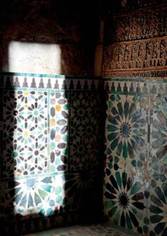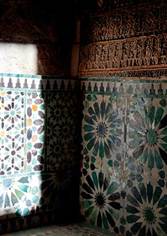Conferences and debates
Index / Activities / Conferences and debates / “Qurtuba / Al-Andalus Conference Series: Beyond the Medina”
“Qurtuba / Al-Andalus Conference Series: Beyond the Medina”
May 20, 20157:30 p.m.
CORDOBA
Casa Árabe Auditorium (at Calle Samuel de los Santos Gener, 9).
7:30 p.m.
Free entrance until the event’s capacity is reached.
Casa Árabe and the Sísifo research group, which forms part of the Archeology area at the University of Cordoba, are presenting this new series of conferences.
The medina was an essential part of Al-Andalus, but it is impossible to fully understand what the medina was truly like without taking a closer look at its borders. Cities in Al-Andalus were closely linked to their peripheries and to the surrounding territory, which supplied them with raw materials, connected them to other cities and towns, and helped to defend Al-Andalus. The ways in which the land was used, the creation of rural habitats, the establishment of defensive networks and the installation of almunias (rural estates) in the outskirts of cities played a fundamental role in the configuration and development of historical realities in Al-Andalus and Qurtuba.
-
 Descubriendo Qurtuba. José Antonio Grueso Alcántara
Descubriendo Qurtuba. José Antonio Grueso AlcántaraFortified peasants in a retreating Al-Andalus (12th century )
February 19, 2015Beyond the Medina,” given by Rafael AzuarIn the second half of the thirteenth century, archeology has documented a generalized process by peasants to concentrate within perfectly fortified settlements, or farmhouses, in which they raised towers to protect the fields for farming in Al-Andalus.These fortified peasant settlements were erected in uninhabited places since Antiquity. They do not appear to be the result of natural growth by peasant communities, but rather are new population groups: they contributed a new type of dwelling, different ceramic housewares and a set of customary handicrafts not documented in earlier times. Moreover, they have not left behind any toponymic marks of a tribal or anthroponymic type in these settlements.For these reasons, and because of their very timelines (prior to the Almohad period, with their origin in the second third of the twelfth century), we believe they must be explained as one of the consequences of the first feudal expansion by the Christian kingdoms from the north of the Iberian Peninsula, which took place in the late eleventh century and first third of the twelfth century. It meant emigration towards the more southern lands of the Muslims, who were expelled en masse from the cities conquered at the borders to the middle and north of Al-Andalus. These populations were forced to take up residence in rural areas, in newly built settlements which are referred to as “colonization,” in unpopulated, uncultured lands, living alongside the ancient aljamas, or populations which had formerly settled in these places. Likewise, the mostly urban origin of these Muslims would explain, in our opinion and in accordance with the archeological remains, the way they designed their settlements, as well as the type of dwellings they built. It reinforces the idea that these were possibly clan-based, and not tribal, groups.Rafael Azuar RuizA doctor of Philosophy and Letters from the University of Alicante, Dr. Azuar Ruiz is a Medieval Archeology specialist. Since 1982, he has been the Cataloguing Conservator of the Alicante Archeological Museum (MARQ), having been its director (1996-2006) and that of the National Underwater Archeology Museum in Cartagena (2006-2010). At present, he is the head of the Excavations and Collections Unit of the MARQ.He has been an Honorary Associate Professor at the University of Alicante (1988-1998) and a member of various advisory commissions on archeology for the Valencian Autonomous Region (1985-1996).His career as a researcher has been marked by dozens of scientific articles and more than ten books devoted to studying the past of the Sharq Al-Andalus through archeology and its relationship with the Mediterranean, encompassing everything from castles to cities. He evaluates works for important scientific journals and forms part of editorial committees (Arqueología y Territorio medieval, Boletín de Arqueología Medieval, Arqueología de la Arquitectura).As a specialist in the archeology of Al-Andalus, his most highly valued contribution has been the discovery and excavation of the unique religious ensemble of the caliph’s Ribat, located in Guardamar del Segura. -
 Descubriendo Qurtuba. José Antonio Grueso Alcántara
Descubriendo Qurtuba. José Antonio Grueso AlcántaraAgriculture and foods in Al-Andalus
April 16, 2015 7:30 p.m.CORDOBACasa Árabe Auditorium (at Calle Samuel de los Santos Gener, 9). 7:30 p.m. Free entrance until the event’s capacity is reached.Expiración Sánchez is offering the second conference in the “Qurtuba / Al-Andalus Conference Series: Beyond the Medina”The Muslims’ arrival on the Iberian Peninsula in the early eighth century marked the beginning of the greatest and most profound development of agriculture on its land, carried out by Arabs and Berbers. This form of agriculture must be understood as farming with irrigation, and more specifically as intensive garden-style agriculture, which meant great innovation and a huge contrast with the preceding historical period. At the same time, new crops were introduced, which spread throughout the entire Islamic world due to travel and migration, above all during the earliest times of expansion. In much the same way, the ancient crops typical of the Mediterranean agricultural system increased in yields with the implementation of new agrarian techniques, which increased the variability of species and helped improve their quality.
One of the main –and most obvious– results of this process of change produced in agriculture was the notable food diversity which arose. These factors, combined with others of a cultural nature (socioeconomic, diet-related, religious, aesthetic, etc.) exerted a direct influence on the change in the food system of the people of Al-Andalus, which gradually evolved, becoming richer and more varied than that which existed in the Iberian Peninsula’s Christian regions. At the same time, the cuisine filled with color, mixtures and matchings of flavors. It truly was not monotonous, unlike the general foodstuffs which could be found on the rest of the peninsula.
Expiración García Sánchez
Ms. García Sánchez has a PhD in Philosophy and Letters in the specialization of Semitic Philology. She is currently a scientific researcher at the School of Arab Studies (EEA) at the Spanish National Research Council (CSIC) and is responsible for the HUM 115 Research Group: Natural Sciences in Muslim Andalusia. Throughout her career, she has worked as a professor in the Department of History of Islam at the University of Granada (1980-1985), the Head of the Structural Unit of Arabic Philology (EEA, 1986-1994) and Head of the Department of Arab Studies of the EEA (1994-1998), as well as having been the Assistant Director of the EEA (1989-1991/1998-2006).
Her research, which has led to many articles and monographic studies of an international scope, has focused mainly on the history of science in Al-Andalus, especially agriculture, botany and related topics, such as historical gardens, pharmacology, foods and dietetics. She has already directed six doctoral theses on this subject. Likewise, she is a member of the editorial board of important scientific journals such as Al-Qantara and Miscelánea de Estudios Árabes y Hebraicos. She has taken part in several domestic and foreign research projects; in approximately 15 of them as the main researcher, having completed a project in 2014 focusing on “Agricultural and Forestry Landscapes in Al-Andalus.”
From 2007 to 2011, at the proposal of the Board of Trustees of the Alhambra and Generalife, she was responsible for the “Plan for Preservation and Management of the Generalife Gardens,” along with Professor J. Estaban Hernández Bermejo (UCO).
.
-
 Descubriendo Qurtuba. José Antonio Grueso Alcántara
Descubriendo Qurtuba. José Antonio Grueso AlcántaraLandscapes of Al-Andalus
May 20, 20157:30 p.m.CóRDOBACasa Árabe Auditorium (at Calle Samuel de los Santos Gener, 9) 7:30 p.m. Free entrance until the event’s capacity is reached.Agricultural systems, peasaant farmer logics, production and subsistence are the subjects of this conference.This talk, the third in the series titled “Qurtuba / Al-Andalus: Beyond the Medina,” will be given by José María Martín Civantos, a professor at the University of Granada.

